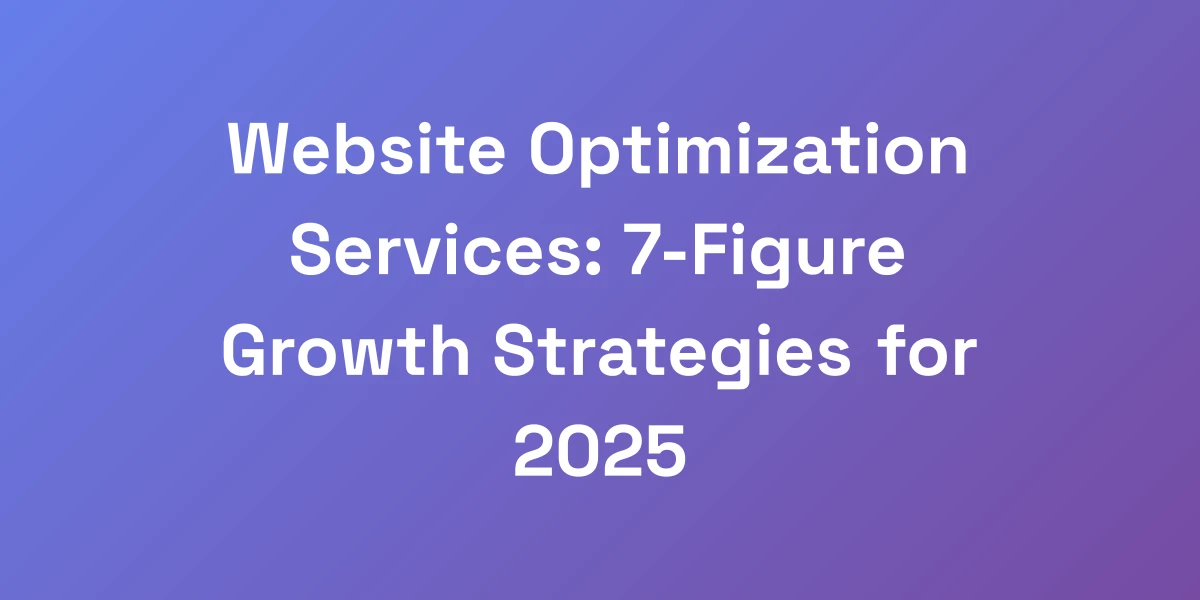
Mobile Website Design: 7 Profit-Driving Strategies for 2025
Mar 18, 2025 | By [email protected]
Why Most Mobile Websites Are Bleeding Money (And How to Fix It)
Let me hit you with some truth: your desktop-first mentality is killing your conversion rates. In 2025, if your website isn’t mobile-optimized, you’re not just losing traffic – you’re burning cash.
We’ve seen it time and again. Companies where a simple mobile-first redesign doubled their revenue overnight. The game has evolved. Mobile users aren’t just browsing anymore; they’re buying, signing up, and making major decisions. But here’s the kicker: most businesses are still designing like it’s 2010, wondering why their conversion rates are in the gutter.
So, what’s going wrong? Why are so many mobile websites failing to capitalize on the massive surge in mobile traffic? It’s not just about having a responsive design; it’s about understanding and implementing strategies that resonate with today’s mobile-savvy consumers.
The Mobile Revenue Revolution: Current Market Statistics
The dominance of mobile in internet usage is undeniable. As of February 2025, mobile traffic accounts for 67.94% of all internet traffic, according to Similarweb. By the end of this year, it’s projected that 72.6% of internet users will access the web solely via their smartphones, as per DataReportal.
These numbers aren’t just statistics; they’re a clear signal. Mobile is not just another channel—it’s the primary gateway to your business. Companies that fail to prioritize mobile are essentially shutting the door on over two-thirds of global internet traffic. Imagine the missed opportunities!
Common Mobile Design Mistakes Costing You Sales
So, what are the common pitfalls? Let’s break them down:
- Poor Navigation: Complicated menus and hidden buttons frustrate users, causing them to abandon your site.
- Slow Load Times: A one-second delay can reduce customer satisfaction by 16% and cause a 20% drop in conversions.
- Non-Responsive Elements: Buttons that are too small or links that are hard to tap can kill conversions.
- Cluttered Layouts: Overwhelming users with too much information leads to decision paralysis.
- Ignoring Touch-Target Sizes: Not adhering to recommended touch-target sizes can make interactions difficult and frustrating.
These mistakes aren’t just minor oversights; they’re revenue killers. Each one chips away at your potential to convert visitors into customers.
The Psychology Behind Mobile User Behavior
Understanding the psychology of mobile users is crucial. Mobile browsing is often done on-the-go, meaning users have less patience and a higher expectation for quick, seamless interactions.
Think about it: when we’re on our phones, we’re multitasking. We switch between apps, respond to messages, and consume content rapidly. This behavior demands a mobile website that is intuitive, fast, and highly responsive.
Moreover, mobile users are more likely to take immediate actions. The convenience of mobile means they’re ready to buy, sign up, or engage right then and there. If your site isn’t optimized to meet these needs, you’re losing out on quick conversions.
Case Study: How Poor Mobile Design Kills Conversion Rates
Consider a mid-sized e-commerce company struggling with declining sales despite increasing traffic. Their desktop site performed well, but their mobile site was underperforming with a conversion rate of just 1.5% compared to desktop’s 3.2%.
After a comprehensive mobile audit, the issues were clear: slow load times, complicated checkout processes, and a confusing navigation structure. By implementing a mobile-first redesign focusing on speed, simplicity, and intuitive navigation, their mobile conversion rate surged to 4.8%, effectively doubling their mobile revenue.
This transformation wasn’t magic—it was a strategic overhaul targeting the root causes of their mobile shortcomings.
The True Cost of Ignoring Mobile Optimization
Ignoring mobile optimization isn’t just about lost sales; it’s about losing trust and credibility. In an era where users expect flawless mobile experiences, a lagging mobile site sends a message that your business is outdated and untrustworthy.
Moreover, search engines like Google prioritize mobile-friendly websites in their rankings. A non-optimized site not only loses potential customers but also suffers in search visibility, compounding the loss of traffic and revenue.
In 2025, the cost of ignoring mobile optimization is steep. It’s not just about immediate losses—it’s about long-term damage to your brand’s reputation and market position.
The Mobile-First Design Framework That Actually Works
Stop overthinking mobile design. I’m going to give you the exact framework that’s generated millions in revenue for our clients. This isn’t about pretty designs – it’s about conversion-focused architecture that turns visitors into customers.
The secret? Strip away everything that doesn’t directly contribute to the sale. Your mobile site needs to be a lean, mean, converting machine. Every pixel should serve a purpose, every button should drive action, and every section should move users closer to the transaction.
The 3-Second Rule for Mobile Homepage Design
First impressions matter. Users decide within the first three seconds if your site is worth their time. Ensure that your homepage clearly communicates your value proposition immediately.
- Clear Headline: Your main message should be visible without scrolling.
- Engaging Visuals: Use high-quality images or videos that align with your brand and message.
- Immediate Call-to-Action: Guide users to the next step right away.
By adhering to the 3-second rule, you capture user interest quickly, reducing bounce rates and increasing the chances of conversion.
Navigation Patterns That Drive Sales
Simplify navigation to guide users seamlessly through your site. Here are some effective patterns:
- Hamburger Menus: Use collapsible menus to keep the interface clean.
- Sticky Navigation: Ensure navigation is always accessible as users scroll.
- Breadcrumbs: Help users understand their location within your site hierarchy.
Effective navigation reduces friction, making it easier for users to find what they’re looking for and complete their desired actions.
The Perfect Mobile Content Hierarchy
Organize your content in a way that prioritizes the most important elements. Here’s how:
- Primary Information: Key messages and CTAs should be at the top.
- Secondary Information: Additional details that support the primary message.
- Tertiary Information: Supplementary content that can enhance user understanding.
By establishing a clear content hierarchy, you guide users through your site effortlessly, increasing engagement and conversions.
Speed Optimization Techniques That Matter
Speed is non-negotiable. Here’s how to turbocharge your mobile site:
- Compress Images: Use tools to reduce image file sizes without compromising quality.
- Minify CSS and JavaScript: Remove unnecessary code to speed up load times.
- Leverage Browser Caching: Store static resources locally to decrease load times on repeat visits.
- Use a Content Delivery Network (CDN): Distribute your content globally to reduce latency.
Implementing these techniques can significantly enhance your site’s performance, leading to higher user satisfaction and better conversion rates.
Mobile-Specific Call-to-Action Strategies
Your CTAs need to stand out and compel action. Here’s how to optimize them for mobile:
- Prominent Placement: Position CTAs where they are easily accessible without excessive scrolling.
- Clear and Concise Text: Use action-oriented language that leaves no ambiguity.
- Contrasting Colors: Ensure CTAs pop against the background for immediate visibility.
- Touchable Size: Make buttons large enough to be easily tapped on mobile screens.
Effective CTAs are critical in guiding users toward conversion, making these strategies essential for maximizing mobile sales.
Advanced Mobile Design Tactics for Maximum Engagement
Let’s get tactical. The difference between a 1% and a 5% conversion rate lies in the details. We’ve tested hundreds of mobile websites and found that specific design patterns consistently outperform others.
We’re talking about micro-interactions that trigger psychological buying responses. From the perfect button size to the ideal scroll depth, every element needs to be optimized for the mobile experience. These aren’t just best practices – they’re profit multipliers.
Touch-Target Optimization Techniques
Touch targets need to be user-friendly. Here’s how to optimize them:
- Size Matters: Ensure buttons are at least 48×48 pixels to accommodate different finger sizes.
- Spacing: Provide adequate spacing between touch targets to prevent accidental taps.
- Feedback: Use visual or tactile feedback to confirm interactions, enhancing user confidence.
Optimizing touch targets improves usability, reducing frustration and increasing the likelihood of conversions.
Mobile-Specific Typography Guidelines
Readable typography is crucial on small screens. Follow these guidelines:
- Font Size: Use a minimum of 16px for body text to ensure readability.
- Line Height: Maintain adequate line spacing (around 1.5) for easy scanning.
- Contrast: Ensure high contrast between text and background for better visibility.
Proper typography enhances the user experience, making content easier to read and engage with, thereby boosting conversions.
Advanced Loading Patterns for Retention
Keep users engaged even while content loads:
- Skeleton Screens: Display placeholders that mimic the layout of the content, reducing perceived load time.
- Progress Indicators: Show visual progress bars to inform users that loading is in progress.
- Lazy Loading: Load images and content as users scroll, improving initial load times.
These loading patterns keep users informed and engaged, preventing them from bouncing due to impatience.
Gesture-Based Interface Elements
Leverage gestures to enhance navigation and interaction:
- Swipe Actions: Allow users to swipe through galleries or navigate between sections effortlessly.
- Tap and Hold: Implement long-press actions for additional options without cluttering the interface.
- Pinch to Zoom: Enable users to zoom in on images or maps for a more detailed view.
Gesture-based elements create a more intuitive and engaging user experience, fostering deeper interaction and higher conversion rates.
Mobile Form Design That Converts
Forms are critical for conversions. Optimize them for mobile:
- Minimal Fields: Only ask for essential information to reduce friction.
- Auto-Fill: Enable auto-fill to expedite the form completion process.
- Progress Indicators: Show users how many steps are left in multi-step forms.
- Inline Validation: Provide real-time feedback to correct errors as users type.
By simplifying forms and enhancing their usability, you increase the likelihood of users completing them, driving more conversions.
Mobile Website Design Tools and Technologies Worth Your Money
Stop wasting time with overcomplicated tech stacks. After spending millions on testing different tools, we can tell you that 80% of your results will come from 20% of the tools. Focus on the tech that directly impacts your bottom line.
Here’s exactly which platforms, frameworks, and testing tools are worth your investment in 2025, and more importantly, which ones to avoid. This isn’t about using the newest shiny object – it’s about using what actually drives revenue.
Essential Mobile Testing Platforms
Reliable testing platforms ensure your mobile site performs flawlessly across devices:
- BrowserStack: Offers real device cloud testing for mobile and web applications, supporting frameworks like Selenium and Appium.
- LambdaTest: Provides AI-native test orchestration on real devices and emulators, ideal for early bug detection and real-device testing.
- Sauce Labs: Facilitates comprehensive testing across multiple platforms, ensuring consistent performance.
These platforms enable thorough testing, helping you identify and fix issues before they impact your users.
Performance Monitoring Tools
Keep track of your site’s performance in real-time:
- Google Analytics: Offers detailed insights into user behavior, traffic sources, and conversion tracking.
- New Relic: Provides comprehensive performance monitoring, identifying bottlenecks and optimizing load times.
- Pingdom: Monitors site speed and uptime, ensuring your mobile site remains reliable.
These tools help you stay on top of performance issues, ensuring a smooth and efficient user experience.
Mobile-First Development Frameworks
Choose frameworks that prioritize mobile performance and responsiveness:
- React Native: Facilitates building high-performance mobile apps with a native look and feel.
- Flutter: Enables fast development with a single codebase, offering smooth and responsive interfaces.
- Vue.js: Known for its simplicity and flexibility, ideal for creating dynamic and responsive mobile websites.
These frameworks provide the foundation for building robust, mobile-optimized websites that enhance user experience and drive conversions.
Analytics Tools for Mobile Optimization
Gain deep insights into your mobile site’s performance:
- Google Analytics: Track user interactions, engagement metrics, and conversion funnels.
- Hotjar: Offers heatmaps, session recordings, and feedback polls to understand user behavior better.
- Mixpanel: Provides advanced analytics for tracking user actions and optimizing conversion paths.
Leveraging these analytics tools allows you to make data-driven decisions, fine-tuning your mobile site for maximum effectiveness. For small businesses looking to enhance their SEO, consider exploring the best SEO services for small business to complement your mobile optimization efforts.
AI-Powered Mobile Design Assistants
Enhance your design process with AI-driven tools:
- Adobe Sensei: Uses AI to streamline design workflows, offering smart recommendations and automations.
- Figma AI: Integrates AI capabilities to assist in creating responsive and user-friendly designs.
- Bookmark: An AI-powered website builder that personalizes design elements based on user preferences and behaviors.
These AI tools not only speed up the design process but also ensure that your mobile site is optimized for user engagement and conversions.
Implementation and Optimization Strategy
Here’s your 30-day plan to transform your mobile website from a liability into a revenue-generating asset. We’ve used this exact process to help businesses increase their mobile conversion rates by 300%.
The key is systematic implementation and relentless testing. We start with the highest-impact changes and work our way down, measuring everything. This isn’t theory – it’s a battle-tested blueprint that works across any industry.
Week-by-Week Implementation Timeline
Break down your 30-day plan into manageable weekly goals:
- Week 1: Conduct a comprehensive mobile audit. Identify key areas for improvement, including speed, navigation, and content hierarchy.
- Week 2: Implement quick wins such as optimizing images, minifying code, and improving touch-target sizes.
- Week 3: Redesign navigation patterns and streamline content based on user behavior insights.
- Week 4: Focus on advanced optimizations like micro-interactions, gesture-based elements, and mobile-specific CTAs.
Each week builds upon the previous one, ensuring a structured and effective transformation of your mobile site.
Key Performance Metrics to Track
Measure the success of your mobile optimization efforts with these metrics:
- Load Time: Aim for under 3 seconds to keep users engaged.
- Conversion Rate: Track the percentage of visitors who complete desired actions.
- Bounce Rate: Monitor the percentage of users who leave after viewing only one page.
- Session Duration: Measure how long users stay on your site, indicating engagement levels.
- Tap Targets: Analyze interaction rates with touch-target elements to ensure usability.
These metrics provide a clear picture of your mobile site’s performance, allowing you to make informed adjustments.
A/B Testing Priority Framework
Implement A/B testing to validate your design changes:
- Identify Critical Elements: Focus on CTAs, navigation menus, and key landing pages.
- Create Hypotheses: Base changes on user behavior data and industry best practices.
- Run Controlled Experiments: Test one variable at a time to accurately measure impact.
- Analyze Results: Use statistical significance to determine the effectiveness of changes.
By prioritizing A/B testing, you ensure that every change contributes positively to your conversion goals.
Common Implementation Pitfalls
Avoid these common mistakes during implementation:
- Ignoring User Feedback: Always consider user insights when making design decisions.
- Overcomplicating Designs: Keep it simple. Cluttered designs can deter users.
- Neglecting Performance: Ensure that optimizations don’t negatively impact site speed.
- Skipping Testing: Thorough testing is essential to identify and fix issues before they affect users.
- Failing to Iterate: Mobile optimization is an ongoing process. Continuously refine and improve your site.
By being aware of these pitfalls, you can navigate the optimization process smoothly and effectively.
Ongoing Optimization Strategies
Once your initial optimization is complete, maintain and enhance your mobile site with these strategies:
- Regular Audits: Periodically review your site’s performance and user experience.
- User Testing: Continuously gather feedback from real users to identify areas for improvement.
- Stay Updated: Keep abreast of the latest mobile design trends and technologies.
- Iterative Improvements: Implement changes in small, manageable increments to continuously enhance your site.
- Monitor Competitors: Keep an eye on your competitors’ mobile strategies to stay ahead.
Ongoing optimization ensures that your mobile site remains relevant, efficient, and effective in driving conversions.
Conclusion
We’ve journeyed through the critical strategies that can transform your mobile website into a profit-driving powerhouse in 2025. From understanding the gravity of mobile-first design to implementing advanced tactics that maximize engagement, the path to mobile success is clear and actionable.
Remember, mobile optimization isn’t a one-time fix—it’s an ongoing commitment to enhancing user experience and driving conversions. By applying these seven strategies, you position your business to not just survive but thrive in the mobile-dominated landscape.
Ready to take your mobile website to the next level? Start implementing these strategies today and watch your conversions soar.
We’d love to hear about your mobile optimization journey. What challenges have you faced, and what successes have you achieved? Share your experiences in the comments below or reach out to us directly. Let’s drive success together!







